
Painting from life: Life Magazine, image: gagosian
In trying to figure out the why, no seriously, WHY? of Bob Dylan’s second [!] painting exhibition at Gagosian [!?], Gallerist NY’s Michael Miller was left with the same Only Possible Explanation that’s been dogging me since the musician’s first baffling Gagosian gig in October 2011:
All I could come up with was a conspiracy theory cooked up by a friend, that both of Mr. Dylan’s shows at Gagosian are actually the work of Richard Prince using “Bob Dylan” as a pseudonym, making the ultimate statement on art and artifice, and proving once and for all that Bob Dylan is whoever you want him to be.
Exactly! It makes perfect sense. Explains everything. Clear as day. All evidence points to it. Every piece of evidence there is. I will go so far as to say that wars have been started with less evidence than this. If Richard Prince were Iraq, we’d have invaded him and pulled him out of his Dylanholes by now, is what I’m saying.
Let’s look at the facts. Or rather, let’s look at the facts while entertaining the possibility that Prince is performing as Dylan the visual artist.
The 2011 show, The Asia Series, were originally presented as–and understood as–a tour documentary. We’re on the bus, walking the street, just hanging, seeing the world as Dylan sees it:
He often draws and paints while on tour, and his motifs bear corresponding impressions of the many different environments and people that he encounters. A keen observer, Dylan works from real life to depict everyday phenomena in such a way that they appear fresh, new, and mysterious.
And if this fantasy come true weren’t enough, Dylan’s real life turns out to be as exotic and mysterious as we’d always imagined The Orient to be:
The Asia Series, a visual journal of his travels in Japan, China, Vietnam, and Korea, comprises firsthand depictions of people, street scenes, architecture and landscape, which can be clearly identified by title and specific cultural details, such as Mae Ling, Cockfight, The Bridge, and Hunan Province. Conversely, there are more cryptic paintings often of personalities and situations, such Big Brother and Opium, or LeBelle Cascade, which looks like a riff on Manet’s Le Déjeuner sur l’Herbe but which is, in fact, a scenographic tourist photo-opportunity in a Tokyo amusement arcade.
That was the setup, the view that held for the first few days before Dylan’s paintings were revealed to be copies, tracings of old photographs. Whether the source was as famous as Henri Cartier-Bresson, as prominent as a new Magnum photo [licensed, apparently, after the fact], or as anonymous and obscure as a collection of 19th century, hand-tinted lantern slides scanned and uploaded to flickr, they had two things in common: 1) they were entirely unacknowledged, and 2) they were thoroughly and inevitably trackable.
In fact, Dylanologists were already on the case; they’d puzzled over the sudden change in Dylan’s painting style as evidenced by the images Gagosian was teasing the show with: a 1966 LIFE magazine cover slightly altered with “pulp references,” and a scene in an opium den which was quickly traced to a 1915 Leon Busy photo by the curator of the Opium Museum.
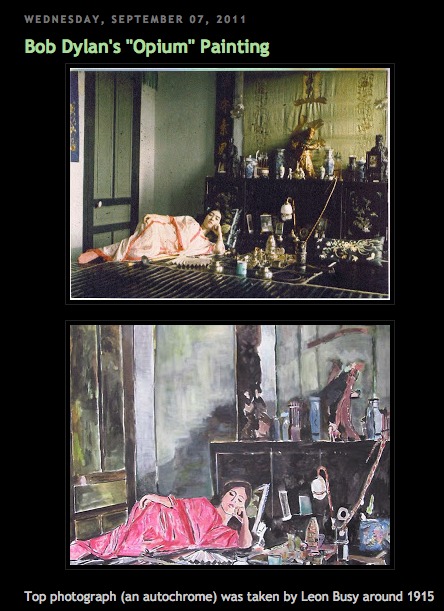
screenshot from amy crehore’s blog, via expectingrain
And then the plagiarizing shit hit the fan. I’m no conspiracy theorist, but the media freakout over Dylan’s Asia Series paintings was so out of proportion to their obvious reality, it seemed staged.


both above from Okinawa Soba’s flickr stream
Instead, it’s the kind of thief/appropriation/credit criticism that has followed Dylan throughout his entire career. Which should give him and Prince something to talk about.

“Welcome to Bob Dylan’s world, Soba-san!” [image: expectingrain.com]
After the photo-based painting controversy broke, Gagosian tweaked the press release: “Dylan works from real life” became “Dylan is inspired by everyday phenomena,” and “a visual journal of his travels” became “a visual reflection,” which is no longer considered “firsthand.” But then, in these mediated days, what is?
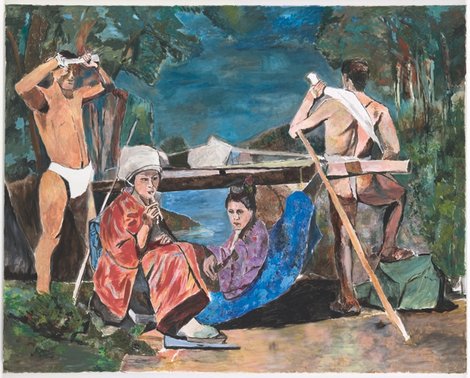
La Belle Cascade, dylan, gagosian via nybooks
I think the key to Dylan’s show is to be found here, in the reality gap between how something is “billed” or presented, and how it is received. Because as Dylan turns out to have told MoMA Chief Curator-turned-Gagosian adviser John Elderfield in the show’s catalogue interview, photographs are part of real life:
A number of the paintings–such as Emperor, La Belle Cascade, Cock Fight, and Shanghai–show very complex scenes. Were these done from sketches, or do you paint from photographs–or from drawings made from photographs–some of the time?
I paint mostly from real life. It has to start with that. Real people, real street scenes, behind-the-curtain scenes, live models, paintings, photographs, staged setups, architecture, grids, graphic design. Whatever it takes to make it work.
But besides the knack for appropriation-fueled outrage, what does any of this have to do with Richard Prince?
It’s true that the outsized criticism of Dylan’s photo-based painting struck me as ridiculous at the time, Fall 2011, when the Cariou v. Prince verdict and appeal were getting increased attention, and when the Corinna Belz’ documentary Gerhard Richter Painting and Richter’s retrospective were both receiving rapturous acclaim. Oh, and when John “yes, that John, right in the middle of it all,” Elderfield was taking his victory lap at MoMA with the last and greatest painting show of his career, the Willem de Kooning retrospective.
And I knew that Prince was involved–maybe implicated was the better word–because I saw he’d written a piece in the Asia Series catalogue, in which he mentioned D.H. Lawrence’s paintings, and compared Dylan’s La Belle Cascade to–holy crap–Cezanne’s Bathers:
The paintings that Dylan showed me out in L.A. were paintings from his travels in Asia. Some of them looked too big for him to have painted them while he was there, so maybe he had done them from memory or a photograph or a sketch or a drawing. I didn’t ask. I didn’t ask a lot of things. I didn’t need to. I just enjoyed the experience. I liked a painting called La Belle Cascade because it looked to me like one of Cézanne’s Bathers. And Cézanne’s Bathers are some of my favorite works of art
And when that essay was republished on the NY Review of Books after the controversy broke, I started wondering about the possible differences between “Dylan’s paintings” and “The paintings Dylan showed me,” and this equivocation about Dylan’s studio suddenly seemed a lot less benign than it had previously:
Dylan’s studio. I think it was Dylan’s studio. I’m still not sure. It didn’t look like any artist’s studio I’d ever been in.
Someone was working to not be pinned down. Prince knew what was up, and so, for that matter, did Elderfield. And so did anyone who looked at a 4-ft, vintage photo-based painting and wondered how the hell anyone, much less Bob Dylan, ever painted it on a Thai tour bus.
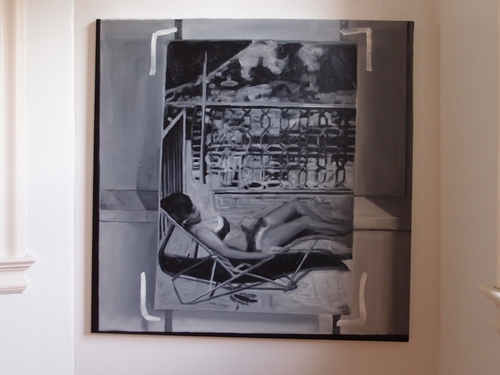
But it wasn’t until a few months later, when I was deep in my own Destroyed Richter Paintings project, and I unrolled the first shipment of canvases from Chinese Paint Mill, that I recognized the painting style–as Bob Dylan’s. The same flatness, the same traced-over-projection line, the same filled-in spaces. Whether he’d ordered them from Chinese Paint Mill or from somewhere/one else, it now seemed obvious that Dylan did not paint his paintings.
Not that outsourcing his fabrication would grant Dylan anything greater than general admission at the contemporary art ball. Fling an iPhone in Chelsea, and you’re bound to hit an outsourcer, a fabricator, or both. These paintings aren’t any less “Dylan’s” or “Dylans” for having been painted by someone else. And are they any more Prince’s or Princes for him having made them? Or having them made? Are those Koonses actually Sarah Morrises? Are those Morrises actually by [names of her painters who call to chat and dish redacted]? That Richter painting Kippenberger table: was or is? Construction with J.J. Flag or Short Circuit?
As long as Dylan signs his paintings–whoops, he doesn’t–well, as long as they’re presented as his, under his name.
And he’s obviously on board with the project. If not, who would have engineered it? At Gagosian? Would Prince have claimed to have visited Dylan’s studio [sic] if it hadn’t happened? Well, yes. But would Elderfield have claimed to have interviewed him? And written two essays for two shows? For a Henry Codax-style, ghost Dylan?
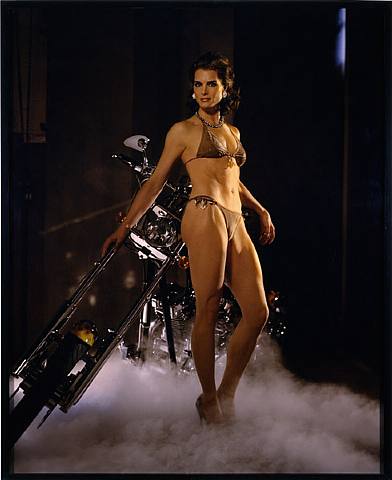
This past Summer, while working on a live restaging of Prince’s Canal Zone lawsuit, I started to sense that outsourcing, or hands-off production, was as important to his own practice as appropriation itself. The hand-off of his Cowboys film to commercial processors was an early example. It stuck when he testified about not meeting a now-grown Brooke Shields in 2005 when Sante D’Orazio shot her for a recreation of Spiritual America [above]:
Q. You just weren’t there?
A. I just–well, I wasn’t there by purpose.
Q. Okay. What was the purpose?
A. To transform the image.
Q. The photo–
A. Yes.
Q.–that Mr. D’Orazio took?
A. Yes. [M]y not being there is a transformative–the absence of the author is I believe a way to transform an image.
[Prince noted that his “contribution” also included selection, or “editing” D’Orazio’s 300 shots down to the one that would get printed. And then he showed it, as an unpublicized surprise, to guests at a private dinner held in the Rivington St. storefront where the original Spiritual America was first shown.]
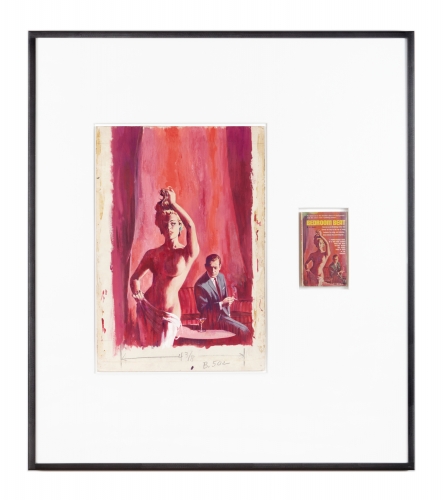
Untitled (Original), 2010, image: fultonryder
In his Fall 2009 deposition Prince also testified of tracking down the original illustrations used for pulp fiction book covers, such as those used in his Nurse paintings. He’d begun pairing these drawings & paintings with the books themselves. Untitled (Original), as the series is called, are featured at Fulton Ryder, Prince’s bookstore. Where, upon close inspection, it is immediately obvious that “the originals” in Untitled (Original)s are actually copies of the covers, which he has created. Or has had created. Commissioned.
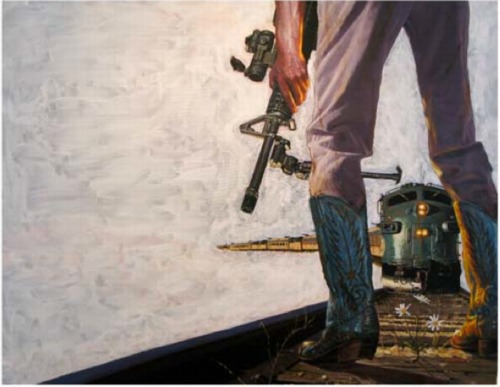
And the Charlie Company paintings [above] he showed in St. Barth at the Eden Roc hotel in 2008? Same thing. They look like reworked details and collages of various he-man adventure pulp covers? But they’re not paint on inkjet, but acrylic on canvas. Different process. Entirely fabricated, Princes painted to order.
Which all brings us to this year’s Dylan show at Gagosian, improbable under the most craven, degraded, celebrity-worshipping cultural best circumstances, Revisionist Art. I confess, I haven’t seen the paintings in person, but from the artists I know who have seen them, I’m better off for it. [I will get to the show, though, before it closes.]
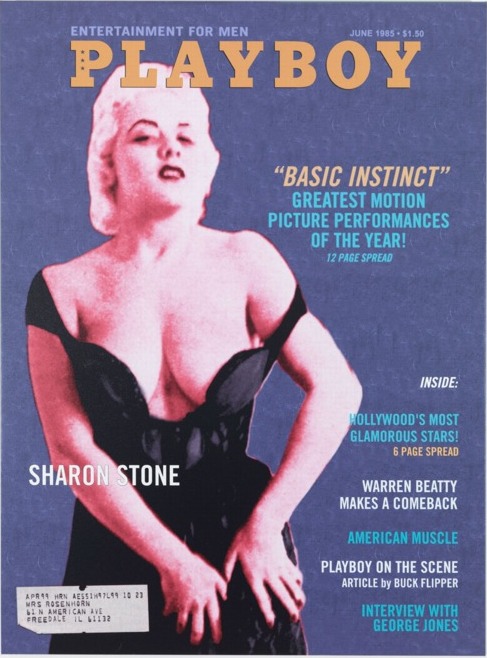
Playboy Magazine, Sharon Stone, 2011-12, image: gagosian
As image/objects, these large, supposedly “silkscreen on canvas” paintings are apparently jaw-droppingly awful. One person called them “wretched,” and couldn’t begin to see how they were silkscreened at all. The only explanation he could come up with was “silkscreen” as a technically accurate description of the 4-color Photoshop separation & printing process. They’re cheap and dead. As objects. And they’re puerile and unfunny and lame as content. Which makes them all the more befuddling and exasperating in their hallowed–or at least blue-chip–context.
Prince had written of the Asia paintings, “I think [they] are good paintings. They’re workmanlike and they do their job.” For the new show, this assessment serves as a lowered bar not to cleared, but to be mamboed under.
And all of which makes me even more certain of Prince’s involvement in Dylan’s painting project, and which makes me suspect that this reaction, the very experience of the paintings and the show, is the artist[s’] central focus.
In such a view, address labels for “Richard Staehung” and “Ricardo Wellhung” are not just sophomoric jokes, they’re signatures. By the guy who makes joke paintings. And autographs.

Bob Dylan with guitar and harmonica, signed photo, dated 1/22/03, POR, via fultonryder
And then you start seeing Prince connections everywhere. The model, for instance, on the mockup cover of Playboy looks like she was photographed en route to an OCTPFAS read-in at “Mr. P’s” shop.
Over the summer, Fulton Ryder’s blog featured this Birdtalk, Prince’s term for the short appropriated texts and aphorisms he’s published throughout his career:
Daniel Boorstin says in his book The Image: A Guide to Pseudo-Events in America: that American life is becoming increasingly organized at every level, and that spontaneous events are being replaced by “pseudo-events”. We find ourselves in a situation where we accept reality as it is reported rather than as it really is: “We become so accustomed to our illusions, our images, that we mistake them for reality.” – Birdtalk
And this Fulton Ryder grouping was posted in September and again in November, just before Dylan’s opening. The titles displayed could be a poetic artist statement for the show:
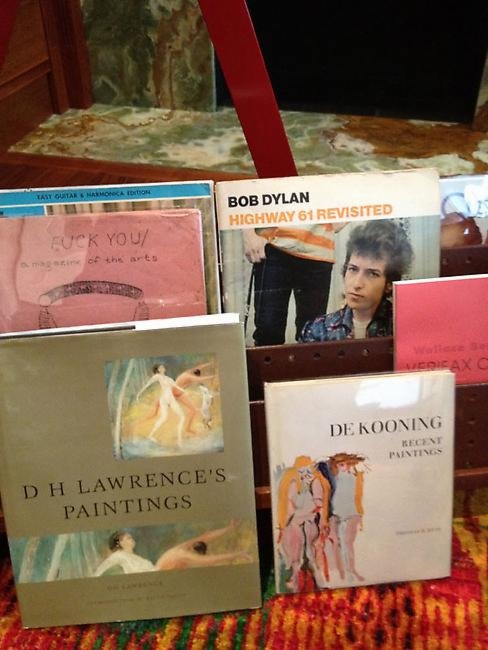
Bob Dylan
Highway 61 Revisited
Wallace Berman Verifax C[ollages]*
De Kooning Recent Paintings
D.H. Lawrence’s Paintings
Fuck You
A magazine of the arts
Easy Guitar & Harmonica Edition
* few days later update: I realize I’d skipped the Berman reference, which is nuts, because Berman’s Verifax collages are ground zero here.
Here’s another one, connecting Lawrence, The Band, and the NY punk era that is Prince’s psychic hometown. To quote the man himself,
Because something is happening here
But you don’t know what it is
Do you, Mister Jones?
To be honest, I looked at John Dogg and Howard Johnson, and, I thought Bob Dylan was just Prince’s giant middle finger to the screwed up art system that doesn’t give enough of a damn to look at what it’s buying and selling and fawning over. Not just the death of the author, but his murder, and the propping up of the author’s corpse, Weekend At Bernie’s-style, in order to keep cashing his checks.
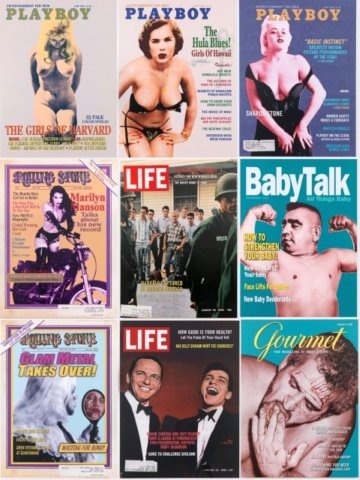
A magazine of the arts: Revisionist Art images ganked from some Danish Dylan messageboard
But then as I was walking it back, trying to see, if not why, then where and when a Prince-for-Dylan relationship might have begun, I hit 2007, the year of Dylan’s first art exhibitions [of overpainted printouts of scans of pages from Drawn Blank, a 1994 book of tour sketches, which, mhmm]. And also the year of Todd Haynes’ remarkable movie I’m Not There, where six different actors portray six different Dylans and various times of his life.
Haynes spent seven years on the project, and a surprising amount of it feels captured in Robert Sullivan’s 2007 tagalong for the New York Times, which is one of the most sensitive and insightful making of stories I’ve ever read.
And I’ll steal Sullivan’s amazing hook here because it’ll only make you want to read the whole thing. It’s about being on the set for the identical mug shots of the Dylans which open the film [they’re in the trailer, too, above]:
Then Haynes took [Ben] Whishaw’s seat on the empty set and, in the video monitor, happened to perfectly align his head with those of all of his Dylans. When I stepped from the wings to look through the camera itself, I saw, in one semimystical, semirevealing moment, the artist as one with the artist he was trying to artificially reassemble.
Because Todd Haynes’ Dylan film isn’t about Dylan. That’s what’s going to be so difficult for people to understand. That’s what’s going to make “I’m Not There” so trying for the really diehard Dylanists. That’s what might upset the non-Dylanists, who may find it hard to figure out why he bothered to make it at all. And that’s why it took Haynes so long to get it made. Haynes was trying to make a Dylan film that is, instead, what Dylan is all about, as he sees it, which is changing, transforming, killing off one Dylan and moving to the next, shedding his artistic skin to stay alive. The twist is that to not be about Dylan can also be said to be true to the subject Dylan.
I think that’s what Prince is trying to do here. To be Dylan, to make a show and art that is what Dylan is all about. To make something real, whatever it takes, in the middle of a screwed up world. To confound and infuriate as you create, and to transform yourself in the process. And suddenly the answer to “Why??” becomes so crystal clear, I’m embarrassed to have even asked: “Because he could, and given the chance, you would, too.”
After I started taking this speculation seriously, and researching and relooking–I guess I could have started with this, but then where’s the fun?–I’ve been sort of, I don’t know, reached out to. [Not by the artist(s), who, how would you be able to believe either one in a situation like this? They’d just add one more refraction of ambiguity.] And holy smokes, people. About this one thing, at least, Prince’s centrality to Dylan’s paintings and shows, I don’t wonder anymore.
How Many Paintings Can One Man Make Before He Decides to Stick to Music? Bob Dylan Gets a Second Show at Gagosian [galleristny]
John Elderfield Interview with Bob Dylan, Spring 2011 [bobdylan]
The Asia Series discussion on Dylan fan site Expecting Rain [36 pgs] [expectingrain]
Deciphering the Asia Series: Dylan, Duchamp and the letter from Woody [swarmuth]
